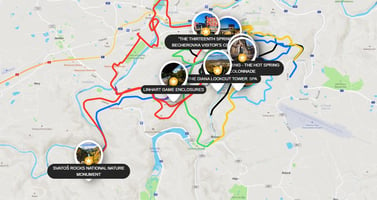Through innovative applications like digital audio guides, even tourist destinations such as UNESCO...
Why should destinations start enriching travel experiences using a self-guided tour app
Self-guided tour apps have seen a steady climb in popularity among travelers seeking more personal and flexible ways to explore destinations. This shift reflects a growing preference for tours that cater to individual interests and schedules, moving away from traditional, one-size-fits-all group tours.
Let's explore why destinations should consider using self-guided tour apps to increase visitor engagement, offering insights on how these digital platforms not only meet the modern traveler's demand for autonomy but also contribute to a more engaging and satisfying travel experience.

A new direction in travel - Personalization and authenticity
Today's travelers are increasingly looking for more than just the traditional sightseeing tours that have dominated the market for decades. The modern tourist is seeking deeper connections with the places they visit, prioritizing activities and explorations that offer a sense of authenticity and personal touch. This move towards valuing genuine interactions with local cultures and environments over merely ticking off major landmarks from a list signifies a great change in what constitutes a fulfilling encounter.
This demand for personalized journeys reflects a broader trend where travelers want to craft their own stories through the places they visit. They prefer choices that allow them to engage directly with their surroundings, selecting paths less traveled to discover hidden gems beyond the surface-level attractions. Self-guided tour apps play a key role in meeting this need, offering the tools for visitors to curate their adventures based on their interests, time, and pace.

Crafting the perfect adventure for visitors - The benefits of self-guided tour apps
Self-guided tour apps offer a combination of ease, insightful content, and customization with the following features, allowing visitors to discover places with a more approachable and fascinating manner.
Flexibility and convenience
These apps represent the zenith of modern travel convenience, allowing tourists to explore destinations on their own terms. The essence of these applications lies in their capacity to provide travelers with the freedom to set their own pace and schedule. Platforms such as SmartGuide lead the way in improving the visitors' interaction through detailed, on-demand information accessible directly on the tourist’s device. The inherent flexibility of self-guided tours means travelers can steer clear of crowds and are not confined by the rigid schedules that accompany group tours. This autonomy enables visitors to plan their explorations during less crowded, off-peak hours, thus aiding in the distribution of tourist numbers throughout the day and promoting sustainable tourism practices.
Personalized recommendations and itineraries
SmartGuide digital audio guide platform, for instance, offers also personalized recommendations based on visitors’ past behavior and preferences through its app by employing a powerful AI model trained to match activities and points of interest to the unique preferences of each traveler. This approach ensures a more bespoke exploration and helps in diverting traffic from over-visited locations to lesser-known gems.

SmartGuide's AI-powered personalized recommendations
Looking ahead, SmartGuide is also poised to introduce a ChatGPT-based itinerary chatbot designed to provide even more finely-tuned routes and itineraries, catering to the specific tastes and interests of users, further improving the personalized travel pathway.
Enhanced learning and engagement
The integration of interactive elements in travel guide apps such as videos, photos, custom quizzes, surveys, games, and AR significantly improves the travel discovery process. These components make the exploration more enjoyable and encourage a deeper connection with the visited sites. By utilizing such technology, these apps bring historical sites and museum exhibits to life, offering context and narratives that improve understanding and appreciation beyond traditional methods. Moreover, feedback mechanisms embedded in many travel guide apps offer valuable insights to content creators, paving the way for continual improvement of digital guide content for visitors.

SmartGuide's augmented reality feature
Cost-effectiveness
From a financial perspective, self-guided tour apps present an economical alternative to hiring personal tour guides. While guided tours at famous European landmarks may impose hefty fees on participants, self-guided tours, accessible via smartphones, markedly reduce this cost, making them an attractive choice for budget-conscious travelers.
Multi-lingual feature
These travel guide apps offer audio tours in multiple languages, thereby, catering to a wide audience including non-native speakers. This feature ensures that more foreign travelers can enjoy their trips, regardless of language barriers, further extending access to cultural and historical knowledge.

Same tour in multiple languages in SmartGuide digital audio guide app
The ripple effect of self-guided tour apps on destinations and local economies
Self-guided tour apps not only modernize the journeys for tourists but also create numerous opportunities for economic growth and sustainable tourism practices in the following ways:
Sparking positive feedback and word-of-mouth marketing
By tailoring to tourists' individual preferences and pace, these digital guides improve the overall visit, prompting explorers to share their positive reviews and recommendations with their friends and family. This personalized approach ensures that each visitor finds content that resonates with them, turning their exploration into a collection of unforgettable moments. Crucially, this stream of positive feedback acts as a powerful channel for word-of-mouth marketing, spreading enthusiasm and endorsements that draw new visitors and boost the destination's appeal.
Sustainable tourism
Self-guided tours promote a move towards less congested and eco-friendly travel habits. By spreading tourists more evenly across various attractions and motivating visits during quieter times, these digital tools help mitigate the impact on popular sites. This method improves the visitors’ involvement by reducing overcrowding and adheres to sustainable tourism principles, ensuring that destinations remain accessible for future visitors.
Economic benefits
The adoption of a self-guided tour app offers economic advantages for local communities. Tourists, equipped with detailed digital guides, are more inclined to visit lesser-known spots and support local establishments, increasing spending at nearby attractions. This facet is notably advantageous from a marketing perspective, as tourist destinations and businesses can prominently display their offerings on digital guide platforms, drawing a broader audience and stimulating economic activity.
Data collection and visitor insights
Self-guided tour apps offer big data insights which has changed the landscape of how destinations gather and interpret information about visitor dynamics and preferences. Through extensive data dashboards of SmartGuide, for example, destinations access valuable quantitative data, such as visitors' origins, demographics, language preferences, and preferred sites. This intel is vital for creating a detailed picture of the current tourism scene and further improving the experience for the visitors.
Additionally, GPS heatmaps offer an in-depth look at where and when visitors show the most interest. These heatmaps are key in evaluating how effectively tours disperse visitors away from congested areas, the seasonal shifts in visitor interest, and the exploration habits of different nationalities.
This dual approach of quantitative and qualitative data provides a complete view of tourist behaviors and preferences, allowing destinations to better manage visitor distribution and plan future content. Utilizing these insights, destinations can boost visitor engagement, encourage a deeper exploration of what they offer, and develop sustainable tourism efforts.

SmartGuide's data analytics - Data dashboards and GPS heatmaps
Essential considerations in the implementation of self-guided tour apps
Implementing self-guided tour apps requires a comprehensive strategy that encompasses the following steps:
- The first vital step involves a deep collaboration with local stakeholders. Engaging local businesses and cultural institutions in the development phase not only improves the content offered by the app but also creates a sense of community ownership over the tourism narrative presented. This cooperative approach ensures that the app showcases a spectrum of experiences, from popular attractions to hidden local gems, thereby offering a more authentic and diverse exploration of the destination.
- Equally important is the development and execution of effective distribution and promotion strategies to attract potential users. Utilizing modern technologies such as QR codes and NFC tags on various marketing materials serves as a dynamic entry point for tourists to access the guide content. These technologies do more than just simplify the acquisition process; they allow for the analysis of engagement data to identify which marketing channels are most effective and which need refinement. By understanding these metrics, destinations can improve their distribution efforts to enhance visibility and user engagement with the app.
- Lastly, the principle of continuous improvement should guide the lifecycle of self-guided tour apps. Regular updates informed by user feedback and technological advancements are crucial. This iterative process ensures that the app remains relevant, functional, and aligned with the evolving interests and needs of its users. Incorporating new content based on direct insights from tourists helps maintain the app’s appeal and utility, making it an indispensable tool for modern explorers.
Successes stories of SmartGuide self-guided tour app’s employment
The following case studies illustrate the significant impact of self-guided tour apps on tourist destinations, showcasing how these digital solutions are successfully altering visitors’ exposure and engagement across the globe.
Karlovy Vary's strategic expansion of visitor interest
Karlovy Vary, known for its therapeutic thermal springs and the iconic Colonnade, faced challenges with high visitor concentration in its main attractions. In collaboration with SmartGuide, the town sought to diversify tourist visits across a wider area. To cater to an international audience, Karlovy Vary introduced four thematic tours available in five languages, as part of an expansive initiative that created almost 30 tours covering both museum interiors and the city's beautiful natural surroundings. A notable customization for Karlovy Vary by SmartGuide included integrating the City Card feature into the app. The "LEISURE" tour, specifically designed to highlight City Card benefits, features audio notifications and distinct markings within the app, driving City Card usage and, consequently, supporting local businesses while encouraging tourists to explore beyond the usual hotspots.

Switzerland's advanced approach to exploration and fitness
The National Tourism Board of Switzerland utilized the SmartGuide platform to offer self-guided walks in 24 Swiss cities. This initiative was aimed at promoting wellness among tourists and locals by encouraging them to achieve their daily target of 10,000 steps while simultaneously discovering secret facts about Switzerland. These tours were made available through a printed brochure and the SmartGuide app, catering to preferences for physical brochures or the convenience of digital access. Switzerland Tourism provided the initial content in four languages, inviting local destinations to contribute further, augmenting the guides with more detailed content.

Through these case studies, it's evident that self-guided tour apps like SmartGuide play an essential role in broadening tourism—balancing the distribution of visitors, strengthening local economies, and providing tours tailored to diverse interests and languages.
Create more meaningful connections for visitors with your destination
Self-guided tour apps reflect a notable transition in how travelers visit destinations, catering to their preferences for flexibility and personalized journeys. These apps offer a wealth of benefits, from allowing tourists to discover sites at their own pace to providing insights into local culture through bespoke recommendations and multilingual audio guides. For destinations and local businesses, the advantages include increased visitor satisfaction, economic growth, and insights into tourism trends through data analysis. This shift toward self-guided digital guides encourages more sustainable and less crowded travel patterns, showcasing the substantial impact these technologies have on both the travel industry and the tourist experience.
Are you ready to adopt self-guided tour apps to create more meaningful connections of visitors with your destination?
.png?width=300&height=69&name=Logo%20SmartGuide%20horizontal%20(1).png)


